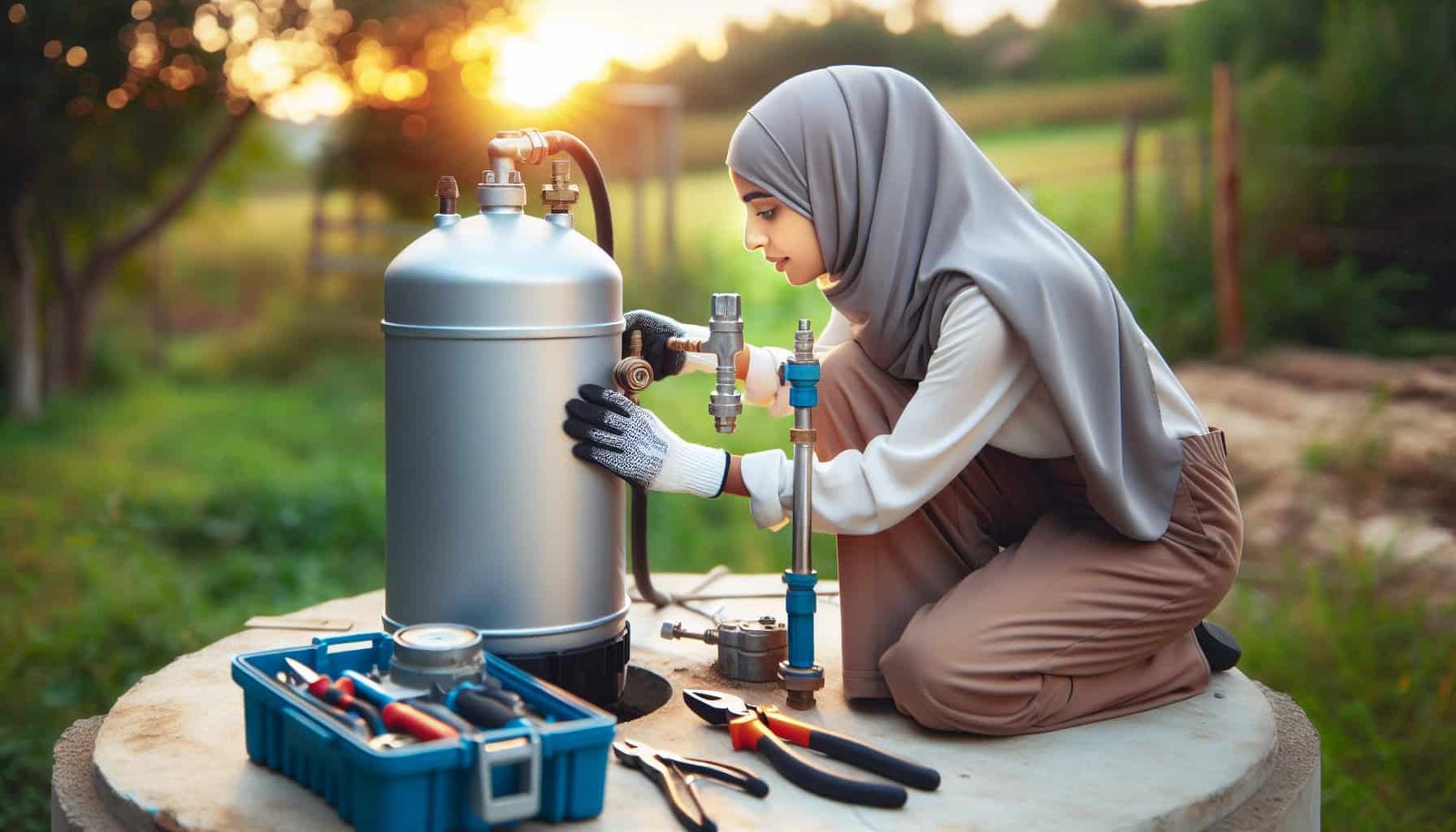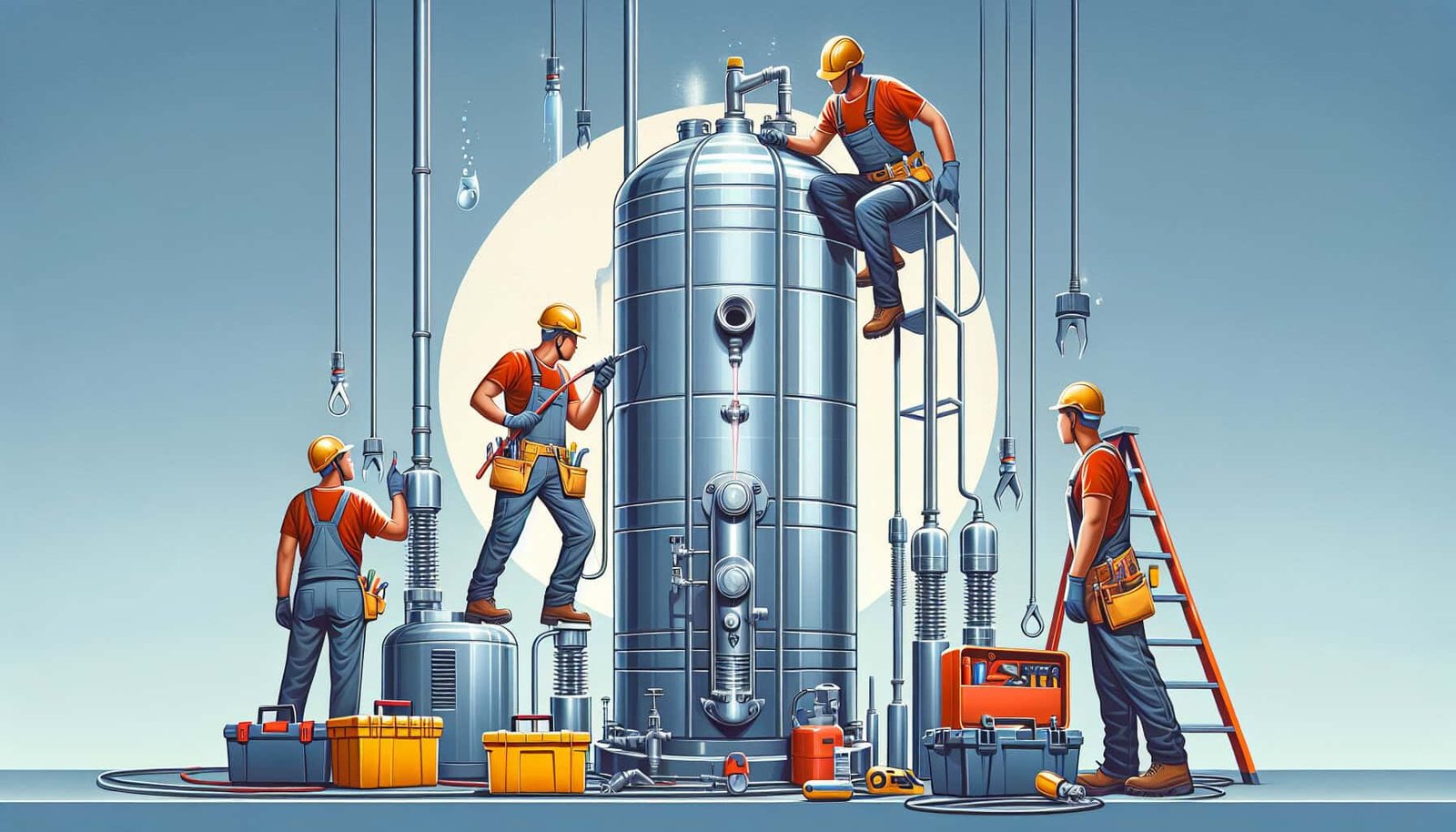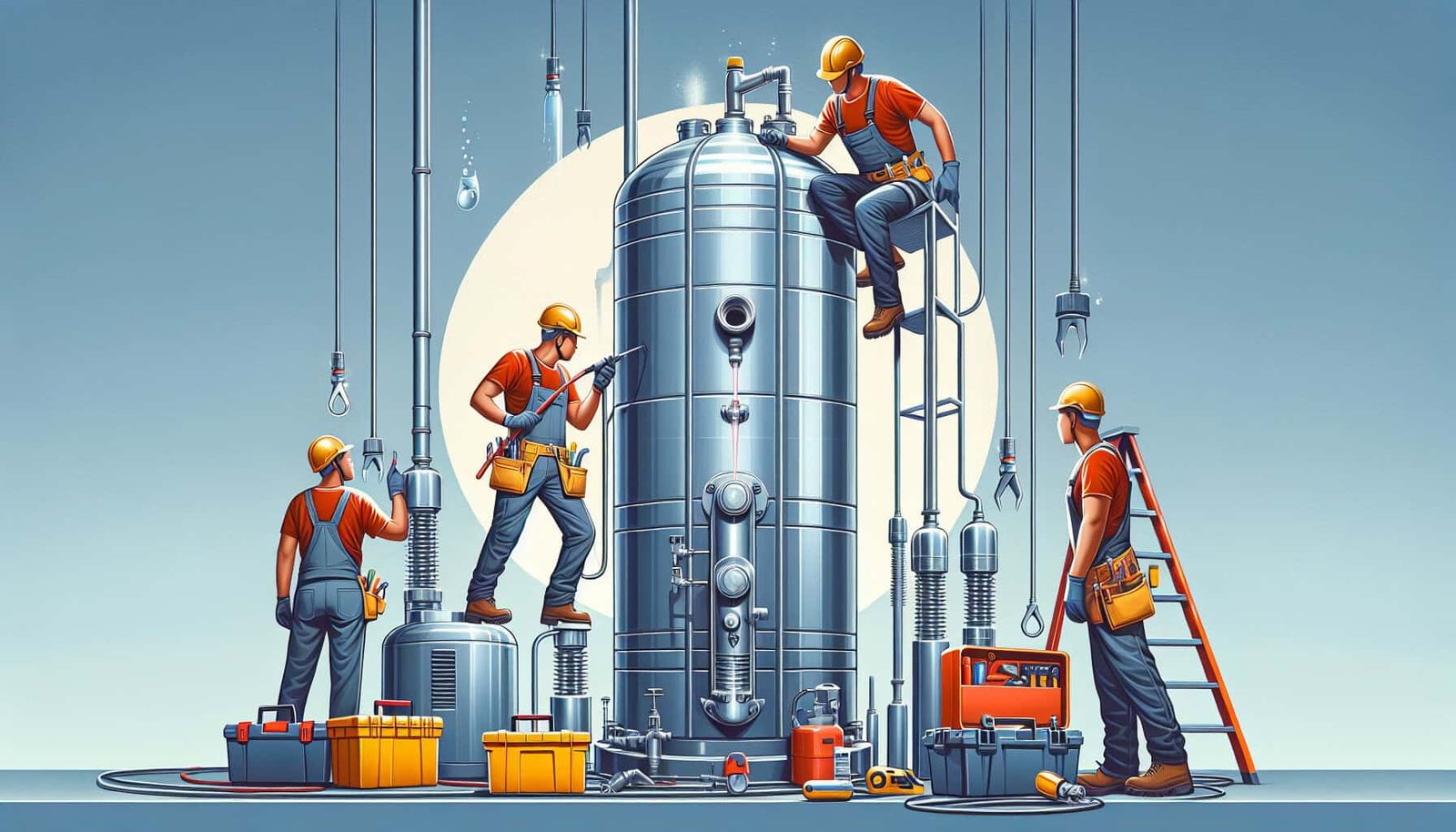In this article, we will explore the importance of safety considerations for well water in areas that have well water pressure tank maintenance schedules. With these maintenance schedules in place, it is crucial to understand the potential risks associated with well water usage and how to mitigate them. By prioritizing safety measures, you can ensure the health and well-being of yourself and your loved ones who rely on well water as their source of clean water. So let’s dive in and learn more about the safety precautions necessary to maintain a healthy well water system.
Importance of Well Water Safety
Impact of Contaminated Well Water
Ensuring the safety of your well water is of utmost importance as contaminated well water can have severe health consequences. Contaminants such as bacteria, parasites, and chemicals can enter your well water and pose a risk to your health when consumed. These contaminants can cause illnesses such as gastrointestinal issues, skin problems, and even long-term health issues. Therefore, it is crucial to prioritize the safety of your well water to prevent these harmful effects.
Benefits of Regular Maintenance
Regular maintenance is key to keeping your well water safe and clean. By regularly inspecting and maintaining your well, you can identify and address any potential issues before they escalate. Regular maintenance can help prevent contamination by ensuring proper functioning of the pressure tank, minimizing the risk of leaks and cracks that could allow contaminants to enter the system. It also helps in identifying any potential problems with the well construction, enabling you to take necessary measures to maintain the integrity of the system. Taking proactive steps towards well maintenance ultimately saves you from costly repairs, protects your health, and ensures the longevity of your well system.
Connection to Pressure Tank Maintenance Schedules
Pressure tanks play a crucial role in maintaining the efficiency and safety of your well water system. It is important to adhere to well water pressure tank maintenance schedules to avoid any potential risks or issues. Regular maintenance of the pressure tank helps in identifying and rectifying any problems with pressure regulation, preventing damage to the tank or other components of the system. Following a maintenance schedule ensures proper functioning of the pressure tank, which in turn, helps maintain the overall safety and quality of your well water.
Understanding Well Water Pressure Tank
Function and Role of Pressure Tanks
Pressure tanks are an integral part of well water systems as they help regulate and maintain water pressure. Their primary function is to store water under pressure, reducing the need for the well pump to turn on and off frequently. When the pressure drops below a certain level, the pressure tank activates the pump to fill it up, ensuring a consistent and steady flow of water throughout the plumbing system. This helps prevent damage to the pump and ensures a continuous supply of water to meet your household needs.
Significance of Well Water Pressure Regulation
Proper pressure regulation is essential for the well water system to function optimally. High water pressure can cause stress on the pipes, leading to leaks and potential damage. On the other hand, low water pressure can disrupt the water flow, making daily activities such as showering, washing dishes, and doing laundry inconvenient. Pressure tanks help regulate the water pressure, maintaining the balance between supply and demand, thus ensuring efficient and safe operation of the entire well water system.
Common Components of Pressure Tanks
Pressure tanks are typically comprised of several key components. The tank itself is usually made of steel or fiberglass and is designed to withstand the internal pressure of the water. It is equipped with an air valve or pressure switch that controls the pressure within the tank. A bladder or diaphragm inside the tank separates the water and air, allowing for proper pressurization. Additionally, pressure tanks have an inlet and outlet connection for the water supply and distribution pipes. Understanding these components is crucial for maintaining and troubleshooting pressure tank issues effectively.

The Role of Maintenance Schedules
Why Maintenance Schedules are Necessary
Maintenance schedules are necessary to ensure the ongoing safety and efficiency of your well water system. Regular maintenance allows you to identify and address any potential issues before they escalate into larger problems. By following a maintenance schedule, you can stay proactive in maintaining the integrity of your well water system, preventing contamination, leaks, or any other malfunctions. Neglecting maintenance can lead to costly repairs, compromise the safety and quality of your well water, and impact the lifespan of essential components such as the pressure tank.
Frequency of Maintenance Checks
The frequency of maintenance checks for your well water system, including the pressure tank, depends on various factors. It is recommended to have a professional inspection and maintenance check conducted at least once a year. These annual check-ups should include a thorough examination of the pressure tank, its components, and the overall well water system. However, it is important to note that certain circumstances may require more frequent checks, such as areas with higher levels of contamination or if you notice any significant changes in water quality or pressure.
Tasks Included in the Schedule
Maintenance schedules for well water systems typically include a range of tasks to ensure optimal functioning and safety. These tasks may include inspecting the pressure tank for any signs of damage, checking the pressure switch and other components for proper operation, testing and adjusting the water pressure, and performing any necessary repairs or replacements. Additionally, the maintenance schedule may also involve testing the water quality, reviewing well construction, and addressing potential contaminant sources. Following the maintenance schedule diligently allows you to address any issues promptly and ensure the ongoing safety and quality of your well water.
Safety Considerations for Well Water
Testing Well Water Quality
Regular testing of your well water quality is essential to ensure the safety of your drinking water. Testing helps in identifying any potential contaminants or problems with the water source. It is recommended to test your well water at least once a year or if you notice any changes in taste, odor, or appearance. The parameters to test may include pH levels, bacteria, nitrates, lead, and other common contaminants. By monitoring the quality of your well water, you can take appropriate measures to address any issues and ensure the safety and health of your household.
Reviewing the Well Construction
Understanding the construction of your well is vital in maintaining its integrity and safety. Regular inspections to review the well construction should be part of your overall maintenance routine. This includes checking for any signs of corrosion, leaks, or physical damage to the well casing and components. Verifying the sanitary seal ensures that the well is properly sealed and prevents the entry of contaminants. By reviewing the well construction regularly, you can identify any potential weaknesses or areas of concern that need to be addressed promptly to maintain the safety and efficiency of your well water system.
Understanding Local Contaminants
Different geographical areas have varying levels and types of contaminants that can affect your well water quality. It is crucial to research and understand the local contaminants that may be present in your area. This knowledge allows you to identify potential health risks associated with these contaminants and take appropriate measures to mitigate them. Consulting with local health authorities or water testing laboratories can provide valuable information on the specific contaminants that may be prevalent in your region. Understanding these local contaminants helps in implementing effective water treatment and filtration solutions to ensure the safety of your well water.
Monitoring Water Pressure and Flow
Regularly monitoring the water pressure and flow in your well water system is important for identifying any issues or malfunctions. This includes keeping an eye on the pressure gauge on the pressure tank and noting any significant changes. Sudden drops or fluctuations in water pressure could indicate problems with the pressure tank, pump, or other components. Additionally, monitoring the flow of water can help identify blockages or restrictions in the plumbing system that may affect the overall efficiency and safety of the well water system. Being vigilant about water pressure and flow allows you to address any problems promptly and maintain the consistent supply of safe and clean well water.

Water Quality Testing
Parameters to Test
When conducting water quality testing for your well water, there are several important parameters to consider. These parameters help determine the overall safety and quality of your drinking water. Key parameters to test include pH levels, total dissolved solids (TDS), bacteria and coliforms, nitrates, lead, and other potential contaminants specific to your area. Testing for pH levels helps assess the acidity or alkalinity of the water, which can impact taste and potentially corrode piping. Bacteria and coliform testing identifies the presence of harmful microorganisms that can cause illnesses. Nitrates and lead testing are essential for identifying potential health risks associated with these contaminants. Testing for other specific contaminants depends on the local area and any known pollution sources.
Frequency of Testing
It is recommended to test your well water at least once a year to ensure ongoing safety and quality. However, certain circumstances may require more frequent testing. For example, if you notice any changes in the appearance, taste, or odor of your well water, it is important to conduct immediate testing to identify and address any issues. Additionally, if there are known local contamination concerns or if there have been changes in the nearby environment, more frequent testing is advisable. Drinking water for vulnerable individuals such as infants, pregnant women, or the elderly may also require more frequent testing to ensure their well-being.
Professional Testing vs. DIY Kits
When it comes to water quality testing, you have the option of either relying on professional testing services or using DIY test kits. Professional testing involves sending water samples to a certified laboratory for analysis. This method ensures the most accurate and comprehensive results, as the samples are analyzed using specialized equipment and techniques. DIY kits, on the other hand, provide a convenient and cost-effective option for basic water testing. While they may not provide the same level of accuracy as professional testing, they can still give you a general idea of the water quality. For more accurate and extensive testing, especially when dealing with specific contaminants or health concerns, it is recommended to opt for professional testing.
Interpreting Test Results
Interpreting the results of your water quality tests is crucial for understanding the safety and quality of your well water. Test results are typically provided in a report that indicates the levels of different parameters tested. The report may include threshold values or guidance on the acceptability of these parameters. Comparing the test results to these guidelines allows you to determine whether your well water meets the required safety standards. If any parameter exceeds the recommended limits or if there are significant changes in test results compared to previous tests, it is important to take appropriate action. This may involve implementing water treatment methods, contacting local health authorities, or consulting with professionals for further guidance.
Well Construction Inspection
Ensuring Proper Well Location
One of the key considerations in well water safety is to ensure proper well location during the construction phase. The well should be located in an area where it is least likely to be affected by contamination sources such as septic systems, animal waste, or chemical storage areas. The proximity to potential contaminant sources should be minimized to reduce the risk of pollutants entering the well. Consulting with qualified well drillers or construction professionals during the initial well construction ensures that the well is situated in an optimal location, minimizing the chances of contamination and supporting the overall safety and integrity of your well water system.
Checking for Well Casing Integrity
Well casing is an important component that helps protect the well from external contaminants. Regular inspections to check for well casing integrity are necessary to ensure its effectiveness in preventing contamination. Visual inspections should be conducted to look for any signs of cracks, corrosion, or physical damage to the well casing. Any openings or weaknesses in the casing can allow pollutants or surface water infiltrate the well, compromising the safety of the well water. Addressing any issues or repairing any damages promptly is crucial to maintain the effectiveness and safety of the well casing.
Verifying Sanitary Seal
The sanitary seal around the well casing is essential for preventing the entry of contaminants into the well. A proper seal prevents surface water, insects, or other debris from entering the well, ensuring the purity and safety of the well water. Inspecting the sanitary seal regularly is important to identify any gaps, cracks, or other issues that may compromise its effectiveness. Any gaps or weaknesses in the sanitary seal should be promptly repaired to maintain the integrity of the seal and prevent potential contamination.
Addressing Potential Contaminant Sources
Identifying and addressing potential contaminant sources in the vicinity of your well is crucial for maintaining the safety of your well water. This may involve evaluating the proximity of septic systems, livestock areas, pesticide storage, or industrial sites to your well. Ensuring proper setbacks and implementing appropriate protective measures can minimize the risk of contaminants infiltrating the well water. Regular monitoring and inspection of these potential sources of contamination allow you to identify any changes or issues that may pose a risk to the safety and quality of your well water. Taking proactive steps to address and mitigate potential contaminant sources is essential for protecting the health and well-being of your household.

Knowledge of Local Contaminants
Researching Area-Specific Contaminants
Every region has its own unique set of potential contaminants that can affect the safety and quality of well water. Researching and understanding the area-specific contaminants helps you identify potential risks and take appropriate preventive measures. Local health authorities, water testing laboratories, or environmental agencies can provide valuable information on the prevalent contaminants in your region. This knowledge allows you to tailor your water testing and treatment efforts to address the specific contaminants that may be present in your well water.
Identifying Potential Health Risks
Once you have identified the area-specific contaminants, it is important to understand the potential health risks associated with them. Different contaminants can have varying health effects, ranging from acute illnesses to long-term chronic conditions. Some contaminants may pose higher risks to vulnerable populations such as infants, pregnant women, or individuals with compromised immune systems. By understanding the potential health risks, you can take appropriate steps to mitigate these risks through water treatment methods, regular testing, or considering alternative water sources. Educating yourself on the potential health effects helps prioritize the safety of your well water and ensure the well-being of your household.
Implementing Appropriate Solutions
Armed with knowledge about area-specific contaminants and their potential risks, you can implement appropriate solutions to ensure the safety of your well water. This may involve using water treatment methods specific to the contaminants identified. For example, filtration systems, activated carbon filters, or UV disinfection can help remove or reduce certain contaminants. It may also involve implementing best management practices to prevent the entry of contaminants into the well, such as proper waste disposal, regular maintenance of septic systems, or avoiding the use of chemicals near the well area. By taking proactive measures and implementing appropriate solutions, you can effectively protect your well water from potential hazards and ensure its safety for consumption.
Monitoring Water Pressure
Importance of Proper Pressure Regulation
Proper pressure regulation is crucial for the well water system to function optimally and safely. High water pressure can cause stress on the pipes, leading to leaks, bursts, or other damage. It can also put excessive strain on the pressure tank and other components, potentially compromising the system’s integrity. Conversely, low water pressure may indicate a problem with the pressure tank, pump, or plumbing system, affecting the overall efficiency and convenience of your water supply. Regularly monitoring and maintaining proper water pressure ensures the safe and consistent flow of well water, minimizing the risk of damage to the system and ensuring an uninterrupted water supply to meet your household needs.
Identifying Pressure Problems
Monitoring water pressure allows you to identify and address any pressure problems that may arise. Any sudden or significant changes in water pressure should be promptly investigated. High water pressure may be indicated by pipes making loud noises or water spurting from fixtures with excessive force. Low water pressure may result in weak or inconsistent water flow from taps, showers, or appliances. These signs can often indicate issues with the pressure tank, control switch, or other parts of the well water system. Promptly addressing pressure problems helps prevent further damage, ensure the efficiency of the system, and maintain the safety of your well water.
Maintaining Optimal Water Flow
In addition to monitoring water pressure, it is important to maintain optimal water flow throughout your well water system. Insufficient flow or restricted water flow can indicate blockages, leaks, or other problems in the plumbing system. These issues can disrupt the distribution of well water and affect the overall efficiency and safety of the system. Regularly checking the flow of water from different fixtures and observing any changes or inconsistencies allows you to identify and resolve any underlying issues promptly. Ensuring an uninterrupted and consistent flow of well water helps maintain the safety and convenience of your household water supply.

Potential Risks and Hazards
Health Risks Associated with Contaminated Well Water
Contaminated well water can pose significant health risks to those who consume it. Bacteria, parasites, or chemical contaminants can lead to gastrointestinal issues such as diarrhea, stomach cramps, or vomiting. Prolonged exposure to certain contaminants may result in chronic health conditions. For example, high levels of nitrates may lead to methemoglobinemia, also known as blue baby syndrome, in infants. Chemical contaminants like arsenic or lead can cause neurological damage, developmental issues, or organ damage. By ensuring the safety and quality of your well water through regular maintenance and testing, you can protect yourself and your family from these potential health risks.
Corrosion and Structural Damage
Corrosion is a common problem in well water systems, particularly in areas with acidic water or high mineral content. Corrosion can lead to the degradation of pipes, well casing, or other metal components, compromising the structural integrity of the system. Leaks, cracks, or other damage resulting from corrosion can allow contaminants to enter the well water, polluting it and posing health risks. Regular maintenance, including inspections for corrosion, helps identify and address any signs of damage before they escalate into larger structural issues. Preventing corrosion through appropriate water treatment methods or pH adjustment helps maintain the safety and longevity of your well water system.
Pressure Tank Failures and Safety Concerns
Pressure tank failures can have serious consequences for the safety and functionality of your well water system. A malfunctioning pressure tank can result in inconsistent water pressure, leading to inconveniences in daily activities and potential damage to plumbing fixtures or appliances. In extreme cases, pressure tank failures can cause bursts or leaks in the pipes, resulting in water damage to your property. Additionally, pressure tank failures may contribute to the entry of contaminants into the well water system, compromising its safety and quality. Regular maintenance checks and adherence to maintenance schedules help identify and address any pressure tank issues promptly, ensuring the continued safety and reliability of your well water system.
Best Practices for Well Water Safety
Regular Maintenance of Pressure Tanks
One of the best practices for well water safety is to prioritize regular maintenance of pressure tanks. By adhering to maintenance schedules and conducting routine inspections, you can identify and address any issues with the pressure tank before they become major problems. This includes checking for signs of damage, testing the pressure switch, and ensuring proper pressure regulation. Regular maintenance helps ensure the proper functioning of the pressure tank, minimizing the risk of contamination, leaks, or other malfunctions that could compromise the safety and quality of your well water.
Water Treatment and Filtration Systems
Implementing appropriate water treatment and filtration systems is another crucial aspect of well water safety. Depending on the specific contaminants that may be present in your well water, different treatment methods may be necessary. Filtration systems, such as activated carbon filters or reverse osmosis systems, can help remove or reduce various contaminants. Water softeners can help address hard water issues caused by high mineral content. Consulting with water treatment professionals or experts can help you identify the most suitable treatment methods for your well water and ensure its safety for consumption.
Engaging Professional Services
Engaging professional services, such as well water system inspections or water testing, is highly recommended for ensuring the safety and quality of your well water. Professionals have the knowledge, experience, and specialized equipment to thoroughly inspect, test, and address any issues with your well water system. They can provide accurate and comprehensive results, guidance on treatment methods, and recommendations for maintenance schedules. Professional services help ensure the ongoing safety and efficiency of your well water, giving you peace of mind and assurance of the quality of your drinking water.
Educating and Raising Awareness
Lastly, educating yourself and raising awareness about well water safety is crucial for protecting your household and promoting the well-being of your community. By understanding the importance of regular maintenance, testing, and treatment, you can take proactive steps to ensure the safety and quality of your well water. Sharing this knowledge with others, including neighbors, friends, or family members, helps raise awareness about the potential risks and the necessary precautions to take. By collectively prioritizing well water safety, we can create safer and healthier environments for everyone relying on well water as their primary water source.
In conclusion, the safety of your well water is of utmost importance. Contaminated well water can have severe health consequences, and regular maintenance is essential in preventing contamination and ensuring the longevity of your well system. Adhering to maintenance schedules for pressure tanks helps maintain the efficiency and safety of your well water system. Testing the water quality, reviewing well construction, understanding local contaminants, and monitoring water pressure and flow all contribute to maintaining the safety and quality of your well water. By implementing best practices, such as regular maintenance, water treatment, engaging professional services, and raising awareness, you can ensure the ongoing safety and well-being of your household.


